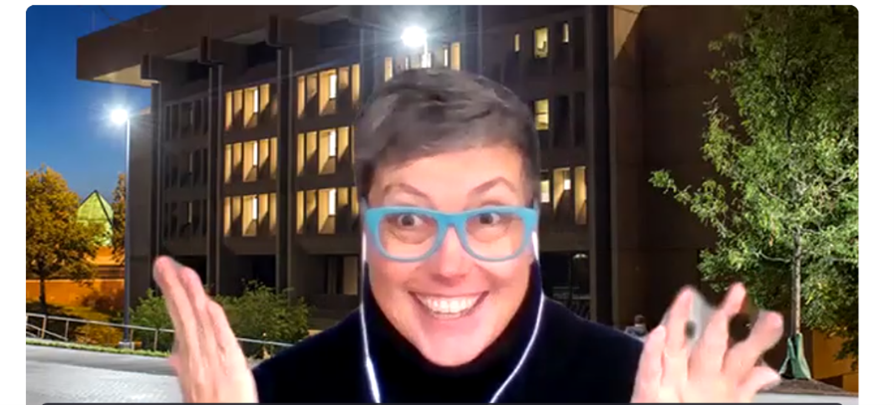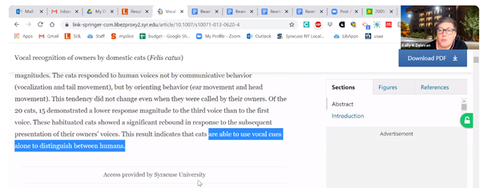Online Teaching

by Kelly Delevan, Information Literacy Librarian
In the spring of 2020 Syracuse University sent students home amid the COVID-19 pandemic, and our semester was interrupted in a myriad of ways. For the Libraries, that meant closing our doors, suspending our collection efforts, and putting in-person instruction on hold while shifting to remote-only instruction. As a librarian who does a fair amount of in-person teaching, this shift was a challenge, to say the least. However, we adapted and learned some lessons along the way.
My Teaching Style
I am an extrovert; my teaching style reflects this. I am animated when I talk, I move around the classroom, and I like to engage directly with students through humor and enthusiasm. I’m not a fan of slide shows; I’ll use them when necessary, but I prefer to do live demonstrations of library resources. For me, the surprise of searching in a database on the fly with students provides an authentic search process; sometimes I fail, sometimes links don’t work. I see this as an opportunity to reiterate to students the “messy” nature of research. This might not work for all instructors, but it works for me. Finally, I LOVE active learning. I always build an activity or two into my lessons. Usually students work individually on a worksheet, or they work in groups to do a research activity, and I roam the classroom providing input as needed.
So, when I had to transition my teaching to a fully remote mode, many aspects of my teaching style were impacted. Gone was the ability to move around the room and chat with students during class time. All the gesturing and pointing to important things looked really silly on screen – I actually caught myself pointing to things on my screen that were completely out of view of my camera! While live demonstrations were fairly similar in an online classroom, my ability to connect the “messy” parts of research sometimes looked more like technological glitches. And active learning was entirely different – it required the most adaptation and patience of all.
Changes Made
While I was unable to move around in an online classroom, I was able to continue to be expressive in smaller ways. Smiling, nodding, and looking directly into the camera went along way in connecting me to the students. The biggest change I made was how I conducted my active learning in the online classroom. I did most of my teaching in Zoom, which allowed breakout rooms where I could assign students into groups to work on activities. I practiced setting up and transitioning between breakout rooms all summer with my colleagues, so I felt really comfortable in that environment. As for activities within the breakout rooms, I relied heavily on google docs to create worksheets and forms that students could edit together, which was fairly similar to filling out a paper worksheet in a traditional classroom.
IL Scholars to the Rescue!
The Information Literacy (IL) Scholars program at SU Libraries employs eight graduate Library Science students this year. They work 10 hours weekly with me to support the Libraries’ instructional efforts, while gaining valuable experience. When we transitioned to online teaching, the IL Scholars were available to serve as teaching assistants to anyone teaching an online instruction session. I had an IL Scholar (or two!) with me in most of my classes and their presence was game changing as they were able to do things like admit students into the rooms, take attendance, and monitor the chat window, which allowed me to stay focused on maintaining a positive presence in the room. I also relied heavily on the IL Scholars to reinforce many of the concepts I was teaching by having them lead students through database demonstrations and keyword brainstorming sessions. When I used breakout rooms, it was wonderful to have an IL Scholar roaming through the rooms with me, so students got more personal attention.
Less Content, More Compassion
Despite all the adjustments I made to my teaching style, and the wonderful help I had, it seemed like there was never really enough time to teach everything in my lesson plan. This is not uncommon for librarians – we are always trying to fit what feels like a semester’s worth of content into one 50 to 75-minute class session. Classroom interactions move slower online. Folks have to mute and unmute, sometimes the audio or the video is bad, screen sharing takes time, etc. Further, I found myself spending time in each class not talking about the library. Honestly, I think that’s okay. In the midst of a global pandemic, just talking with students, asking them how they were coping, and acknowledging their concerns was necessary pedagogy. In every class I taught, it was extremely important to me that I made it clear that our mental and physical well-being came first. If we weren’t able to cover all of the library related content, the students and their faculty understood. We as librarians are really great at creating supplemental resources like research guides and tutorials that can be viewed outside of class. If something wasn’t addressed in class, I sent the professor a link to a helpful resource later, and of course, the Libraries offer an amazing array of reference services that I always recommended.
Moving Forward
I really hope that I can return to the physical classroom soon. As much as I have worked to adapt my teaching to the virtual classroom, I still find my own teaching style works best in person. Until that day comes I’ll continue to try and find ways to make the online classroom one where we can learn from each other, and laugh a lot along the way.

